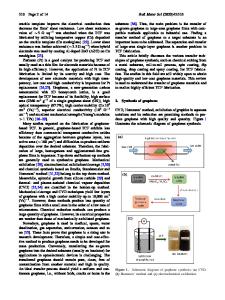A review of graphene synthesis by indirect and direct deposition methods
- PDF / 837,055 Bytes
- 14 Pages / 584.957 x 782.986 pts Page_size
- 102 Downloads / 862 Views
FOCUS ISSUE
2D AND NANOMATERIALS
A review of graphene synthesis by indirect and direct deposition methods Yanxia Wu1,b), Shengxi Wang1, Kyriakos Komvopoulos1,a) 1
Department of Mechanical Engineering, University of California, Berkeley, California 94720, USA Address all correspondence to this author. e-mail: [email protected] b) Permanent address: Institute of New Carbon Materials, Taiyuan University of Technology, Taiyuan 030024, China. a)
Received: 13 September 2019; accepted: 21 November 2019
The unique properties of graphene have led to the use of this allotrope of carbon in a wide range of applications, including semiconductors, energy devices, diffusion barriers, heat spreaders, and protective overcoats. The synthesis of graphene by process methods that either directly or indirectly rely on physical vapor deposition, thermal annealing, laser irradiation, and ion/electron beam irradiation has drawn significant attention in recent years, mainly because they can provide high purity, low temperature, high throughput, and controllable growth of graphene on various substrates. This article provides a comprehensive assessment of these methods by grouping them into two main categories, i.e., indirect methods in which a carbon layer is first deposited on a substrate and then converted to graphene by some type of energetic post-treatment process and direct methods in which graphene is directly synthesized on a substrate surface by a process that uses a solid carbon source. The underlying growth mechanisms of these processes and the challenging issues that need to be overcome before further advances in graphene synthesis can occur are interpreted in the context of published results.
Introduction The explosion of research dealing with two-dimensional (2D) materials, such as graphene, has been fueled by their novel material intricacies and the exploitation of their unique electronic, mechanical, and optical properties. 2D materials are layered structures of atomic- or nano-scale thickness, which are used in various applications (e.g., semiconductors, electronics, sensors, energy storage devices, photovoltaics, filters, and composite materials) due to their unprecedented physical properties. Since 2D materials exhibit the highest surface-to-volume ratio among all materials, facile production of these materials can accelerate the development of new approaches for tuning and improving the surface characteristics of bulk materials and contribute to the discovery of disruptive methods for assembling miniaturized devices with novel functionalities and prolonged operation lifetimes. The field of 2D materials owes its establishment to the discovery of graphene in 2004. Graphene consists of sp2 hybridized carbon atoms demonstrating hexagonal, Bernal, or
ª Materials Research Society 2020
rhombohedral stacking [1], with partially filled p orbitals existing above and below the graphene plane [2]. A graphitic layer is known as single-layer graphene; 2–3 graphitic layers stacked together are termed bilayer and trilayer graphe
Data Loading...











